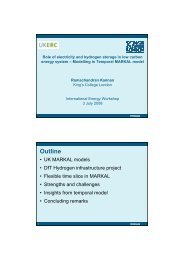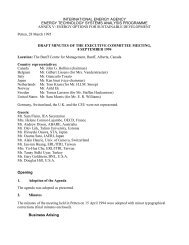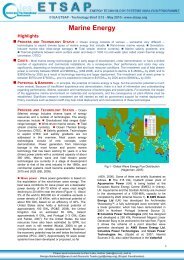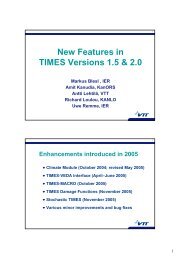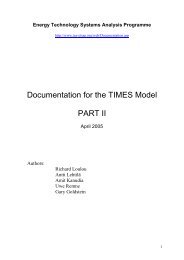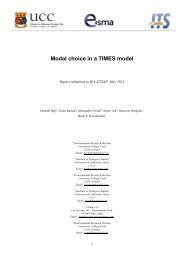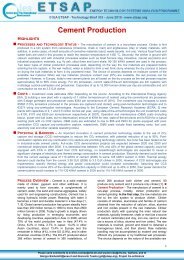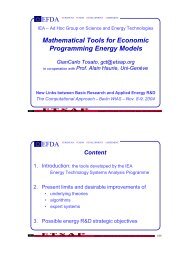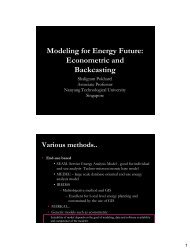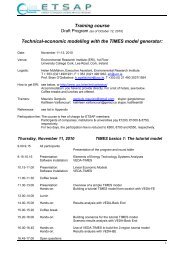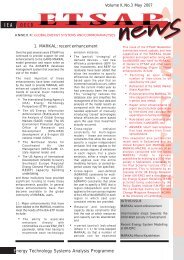Documentation for the MARKAL Family of Models - iea-etsap
Documentation for the MARKAL Family of Models - iea-etsap
Documentation for the MARKAL Family of Models - iea-etsap
You also want an ePaper? Increase the reach of your titles
YUMPU automatically turns print PDFs into web optimized ePapers that Google loves.
grow t is <strong>the</strong> potential growth rate at period t<br />
kpvs and kgdp can be extracted from macro-economic statistics like national accounts. As<br />
<strong>the</strong>y may fluctuate, multiple-year averages are more appropriate than single year values.<br />
Some care must be taken, and consultation <strong>of</strong> macro-economists familiar with such<br />
statistics and <strong>the</strong>ir definitions is strongly recommended. For OECD economies, typical<br />
kpvs estimates range from 0.2 to 0.3. For less developed, but rapidly growing economies<br />
substantially, higher values are quoted. Again <strong>for</strong> OECD economies, kgdp estimates may<br />
range from roughly 2 to 3. In <strong>the</strong> absence <strong>of</strong> specific in<strong>for</strong>mation, a rule-<strong>of</strong>-thumb ratio <strong>of</strong><br />
10:1 (say 2.5 and 0.25) can be adopted <strong>for</strong> kgdp over kpvs, but must be lowered in case <strong>of</strong><br />
anticipated rapid growth. The depreciation rate depr t may be taken equal or close to <strong>the</strong><br />
<strong>MARKAL</strong> discount rate.<br />
3.4 O<strong>the</strong>r Modeling Issues<br />
3.4.1 Increasing period length via COLLAPSE<br />
Since <strong>MARKAL</strong>-MACRO is a non-linear optimization problem, it may be desirable to<br />
try and reduce its overall size, <strong>for</strong> instance by increasing period length. The COLLAPSE<br />
option converts an instance with 5-year period length into one with 10-year period length.<br />
COLLAPSE makes a number <strong>of</strong> changes to <strong>the</strong> parameters <strong>of</strong> a <strong>MARKAL</strong> database,<br />
including START, LIFE, BOUNDS, etc. It is strongly recommended to check <strong>the</strong> log file<br />
created by this utility be<strong>for</strong>e proceeding to <strong>MARKAL</strong>-MACRO it will also be helpful to<br />
find <strong>the</strong> cause <strong>of</strong> infeasibilities arising after COLLAPSE is switched on.<br />
3.4.2 Differential Costing<br />
In most <strong>MARKAL</strong> models, <strong>the</strong> investment cost <strong>of</strong> end-use technologies is fully modeled.<br />
In some sectors, <strong>the</strong> cost modeled in <strong>MARKAL</strong> may include <strong>the</strong> cost <strong>of</strong> equipment that<br />
does not qualify as an energy expenditure. For instance, <strong>the</strong> investment cost <strong>of</strong> an<br />
automobile may represent <strong>the</strong> full cost <strong>of</strong> buying <strong>the</strong> car. There<strong>for</strong>e, <strong>the</strong> aggregate cost<br />
function <strong>of</strong> <strong>MARKAL</strong> may overestimate <strong>the</strong> pure energy cost that is required by MACRO.<br />
In some o<strong>the</strong>r sector such as residential space heating, <strong>the</strong> full cost <strong>of</strong> a space heating<br />
device should be fully accounted <strong>for</strong> in <strong>the</strong> MACRO energy cost. To remedy this problem,<br />
a <strong>MARKAL</strong>-MACRO utility will subtract <strong>the</strong> undesirable portion <strong>of</strong> <strong>the</strong> investment cost <strong>of</strong><br />
some or all end-use technologies as follows: consider <strong>the</strong> set <strong>of</strong> INVCOST k values <strong>for</strong> all<br />
technologies k fulfilling a given demand. The utility will subtract from each INVCOST k<br />
<strong>the</strong> smallest such cost. The INVCOST k ’s thus obtained now represent <strong>the</strong> differential costs<br />
<strong>of</strong> each technology, and not <strong>the</strong> full costs The user has full control over which demands<br />
should be treated in this way, and which not. Again, actions taken by <strong>the</strong> utility are listed in<br />
a log file that may be consulted by <strong>the</strong> user.<br />
395



